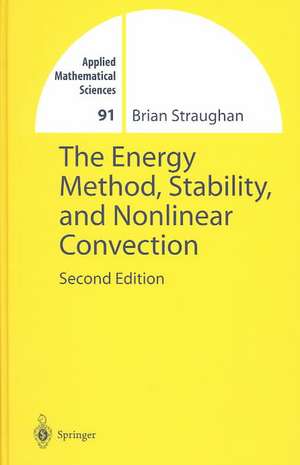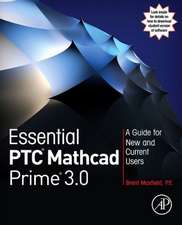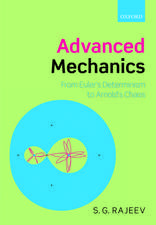The Energy Method, Stability, and Nonlinear Convection: Applied Mathematical Sciences, cartea 91
Autor Brian Straughanen Limba Engleză Hardback – oct 2003
| Toate formatele și edițiile | Preț | Express |
|---|---|---|
| Paperback (1) | 648.56 lei 6-8 săpt. | |
| Springer – 29 noi 2010 | 648.56 lei 6-8 săpt. | |
| Hardback (1) | 652.49 lei 6-8 săpt. | |
| Springer – oct 2003 | 652.49 lei 6-8 săpt. |
Din seria Applied Mathematical Sciences
- 13%
 Preț: 426.94 lei
Preț: 426.94 lei - 13%
 Preț: 426.46 lei
Preț: 426.46 lei - 13%
 Preț: 427.63 lei
Preț: 427.63 lei - 9%
 Preț: 1728.59 lei
Preț: 1728.59 lei - 24%
 Preț: 906.80 lei
Preț: 906.80 lei - 23%
 Preț: 659.07 lei
Preț: 659.07 lei -
 Preț: 375.65 lei
Preț: 375.65 lei - 18%
 Preț: 909.47 lei
Preț: 909.47 lei - 18%
 Preț: 795.02 lei
Preț: 795.02 lei - 18%
 Preț: 950.52 lei
Preț: 950.52 lei - 15%
 Preț: 645.47 lei
Preț: 645.47 lei - 20%
 Preț: 755.49 lei
Preț: 755.49 lei -
 Preț: 382.67 lei
Preț: 382.67 lei - 24%
 Preț: 808.06 lei
Preț: 808.06 lei -
 Preț: 452.62 lei
Preț: 452.62 lei -
 Preț: 190.23 lei
Preț: 190.23 lei -
 Preț: 399.12 lei
Preț: 399.12 lei - 18%
 Preț: 966.90 lei
Preț: 966.90 lei - 15%
 Preț: 643.48 lei
Preț: 643.48 lei - 15%
 Preț: 528.80 lei
Preț: 528.80 lei -
 Preț: 413.15 lei
Preț: 413.15 lei -
 Preț: 390.25 lei
Preț: 390.25 lei - 18%
 Preț: 736.01 lei
Preț: 736.01 lei - 18%
 Preț: 1411.05 lei
Preț: 1411.05 lei - 15%
 Preț: 711.21 lei
Preț: 711.21 lei -
 Preț: 395.47 lei
Preț: 395.47 lei - 18%
 Preț: 1017.26 lei
Preț: 1017.26 lei -
 Preț: 403.15 lei
Preț: 403.15 lei - 18%
 Preț: 1130.14 lei
Preț: 1130.14 lei - 18%
 Preț: 1134.87 lei
Preț: 1134.87 lei - 18%
 Preț: 1329.00 lei
Preț: 1329.00 lei - 18%
 Preț: 1129.65 lei
Preț: 1129.65 lei - 18%
 Preț: 1140.71 lei
Preț: 1140.71 lei
Preț: 652.49 lei
Preț vechi: 767.63 lei
-15% Nou
Puncte Express: 979
Preț estimativ în valută:
124.85€ • 130.37$ • 103.10£
124.85€ • 130.37$ • 103.10£
Carte tipărită la comandă
Livrare economică 15-29 aprilie
Preluare comenzi: 021 569.72.76
Specificații
ISBN-13: 9780387004532
ISBN-10: 038700453X
Pagini: 450
Ilustrații: XII, 450 p.
Dimensiuni: 155 x 235 x 26 mm
Greutate: 0.75 kg
Ediția:2nd ed. 2004
Editura: Springer
Colecția Springer
Seria Applied Mathematical Sciences
Locul publicării:New York, NY, United States
ISBN-10: 038700453X
Pagini: 450
Ilustrații: XII, 450 p.
Dimensiuni: 155 x 235 x 26 mm
Greutate: 0.75 kg
Ediția:2nd ed. 2004
Editura: Springer
Colecția Springer
Seria Applied Mathematical Sciences
Locul publicării:New York, NY, United States
Public țintă
ResearchCuprins
1 Introduction.- 2 Illustration of the energy method.- 3 The Navier-Stokes equations and the Bénard problem.- 4 Symmetry, competing effects, and coupling parameters.- 5 Convection problems in a half space.- 6 Generalized energies and the Lyapunov method.- 7 Geophysical problems.- 8 Surface tension driven convection.- 9 Convection in generalized fluids.- 10 Time dependent basic states.- 11 Electrohydrodynamic and magnetohydrodynamic convection.- 12 Ferrohydrodynamic convection.- 13 Reacting viscous fluids.- 14 Multi-component convection diffusion.- 15 Convection in a compressible fluid.- 16 Temperature dependent fluid properties.- 17 Penetrative convection.- 18 Nonlinear stability in ocean circulation models.- 19 Numerical solution of eigenvalue problems.- A Useful inequalities.- A.1 The Poincaré inequality.- A.2 The Wirtinger inequality.- A.3 The Sobolev inequality.- A.4 An inequality for the supremum of a function.- A.7 A two-dimensional surface inequality.- A.8 Inequality (A.20) is false in three-dimensions.- References.
Recenzii
From the reviews of the second edition:
"This application-oriented book is a revised edition … more definitions, new interpretations and new results are included, some chapters are enlarged, 6 chapters are added. … the presentation is very clear, making the book useful to undergraduate and graduate students in applied mathematics too. … The main text and the very rich list of references reflect the interests and results of the author and his collaborators. The book makes a good contribution to the literature on stability of fluid flows … ." (Adelina Georgescu, Mathematical Reviews, 2004i)
"This application-oriented book is a revised edition … more definitions, new interpretations and new results are included, some chapters are enlarged, 6 chapters are added. … the presentation is very clear, making the book useful to undergraduate and graduate students in applied mathematics too. … The main text and the very rich list of references reflect the interests and results of the author and his collaborators. The book makes a good contribution to the literature on stability of fluid flows … ." (Adelina Georgescu, Mathematical Reviews, 2004i)
Textul de pe ultima copertă
This book describes the energy method, a powerful technique for deriving nonlinear stability estimates in thermal convection contexts. It includes a very readable introduction to the subject (Chapters 2-4), which begins at an elementary level and explains the energy method in great detail, and also covers the current topic of convection in porous media, introducing simple models and then showing how useful stability results can be derived. In addition to the basic explanation, many examples from diverse areas of fluid mechanics are described. The book also mentions new areas where the methods are being used, for example, mathematical biology and finance. Several of the results given are published here for the first time.
This volume is a completely revised version of the first edition published in 1992. In addition to an update of material from the first edition, six new chapters have been added, covering topics such as multi-component convection-diffusion, convection flows in a compressible fluid, models of penetrative convection, convection with temperature-dependent viscosity and thermal conductivity, and stability of ocean flows. The final chapter gives details of two very different but highly accurate and efficient methods for numerically solving eigenvalue problems that arise in hydrodynamic stability.
The new methods developed during the last eleven years and presented here will be of use to many readers in applied mathematics, engineering, physics, and other mathematical disciplines.
This volume is a completely revised version of the first edition published in 1992. In addition to an update of material from the first edition, six new chapters have been added, covering topics such as multi-component convection-diffusion, convection flows in a compressible fluid, models of penetrative convection, convection with temperature-dependent viscosity and thermal conductivity, and stability of ocean flows. The final chapter gives details of two very different but highly accurate and efficient methods for numerically solving eigenvalue problems that arise in hydrodynamic stability.
The new methods developed during the last eleven years and presented here will be of use to many readers in applied mathematics, engineering, physics, and other mathematical disciplines.
Caracteristici
Includes supplementary material: sn.pub/extras













